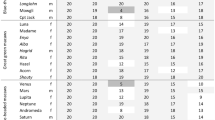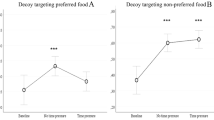Abstract
Money is a cultural artefact with a central role in human society. Here, we investigated whether some features of money may be traced back to the exchange habits of nonhuman animals, capitalizing on their ability to flexibly use tokens in different domains. In Experiment 1, we evaluated whether capuchins can recognize token validity. Six subjects were required to exchange with the experimenter valid/familiar tokens, valid/unfamiliar tokens, invalid tokens, and no-value items. They first exchanged a similar number of valid/familiar and valid/unfamiliar tokens, followed by exchanges of invalid tokens and no-value items. Thus, as humans, capuchins readily recognized token validity, regardless of familiarity. In Experiment 2, we further evaluated the flexibility of the token–food association by assessing whether capuchins could engage in reverse food–token exchanges. Subjects spontaneously performed chains of exchanges, in which a food item was exchanged for a token, and then the token was exchanged for another food. However, performance was better as the advantage gained from the exchange increased. Overall, capuchins recognized token validity and successfully engaged in chains of reverse and direct exchanges. This suggests that—although nonhuman animals are far from having fully-fledged monetary systems—for capuchins tokens share at least some features with human money.








Similar content being viewed by others
References
Addessi E, Rossi S (2011) Tokens improve capuchin performance in the reverse–reward contingency task. Proc R Soc Lond Biol 278:849–854. https://doi.org/10.1098/rspb.2010.1602
Addessi E, Stammati M, Sabbatini G, Visalberghi E (2005) How tufted capuchin monkeys (Cebus apella) rank monkey chow in relation to other foods. Anim Welfare 14:215–222
Addessi E, Crescimbene L, Visalberghi E (2007) Do capuchin monkeys (Cebus apella) use tokens as symbols? Proc R Soc Lond Biol 274:2579–2585. https://doi.org/10.1098/rspb.2007.0726
Addessi E, Crescimbene L, Visalberghi E (2008a) Food and token quantity discrimination in capuchin monkeys (Cebus apella). Anim Cogn 11:275–282. https://doi.org/10.1007/s10071-007-0111-6
Addessi E, Mancini A, Crescimbene L, Padoa-Schioppa C, Visalberghi E (2008b) Preference transitivity and symbolic representation in capuchin monkeys (Cebus apella). PLoS One 3(6):e2414. https://doi.org/10.1371/journal.pone.0002414
Addessi E, Mancini A, Crescimbene L, Ariely D, Visalberghi E (2010) How to spend a token? Trade-offs between food variety and food preference in tufted capuchin monkeys (Cebus apella). Behav Process 83:267–275. https://doi.org/10.1016/j.beproc.2009.12.012
Addessi E, Mancini A, Crescimbene L, Visalberghi E (2011) How social context, token value, and time course affect token exchange in capuchin monkeys (Cebus apella). Int J Primatol 32:83–98. https://doi.org/10.1007/s10764-010-9440-4
Addessi E, Paglieri F, Beran MJ, Evans TA, Macchitella L, De Petrillo F, Focaroli V (2013) Delay choice versus delay maintenance: different measures of delayed gratification in capuchin monkeys (Cebus apella). J Comp Psychol 127:392–398. https://doi.org/10.1037/a0031869
Addessi E, Bellagamba F, Delfino A, De Petrillo F, Focaroli V, Macchitella L, Maggiorelli V, Pace B, Pecora G, Rossi S, Sbaffi A, Tasselli MI, Paglieri F (2014) Waiting by mistake: Symbolic representation of rewards modulate intertemporal choice in capuchin monkeys (Cebus apella), preschool children and adult humans. Cognition 130:428–441. https://doi.org/10.1016/j.cognition.2013.11.019
Andrade LF, Hackenberg TD (2017) Substitution effects in a generalized token economy with pigeons. J Exp Anal Behav 107:123–135. https://doi.org/10.1002/jeab.231
Beran MJ, Evans TA (2012) Language-trained chimpanzees (Pan troglodytes) delay gratification by choosing token exchange over immediate reward consumption. Am J Primatol 74:864–870. https://doi.org/10.1002/ajp.20474
Beran MJ, Evans T, Hoyle D (2011) Numerical judgments by chimpanzees (Pan troglodytes) in a token economy. J Exp Psychol Anim Behav Process 37:165–174. https://doi.org/10.1037/a0021472
Beran MJ, Rossettie MS, Parrish AE (2016) Trading up: Chimpanzees (Pan troglodytes) show self-control through their exchange behavior. Anim Cogn 19:109–121
Brosnan SF, Beran MJ (2009) Trading behavior between conspecifics in chimpanzees, Pan troglodytes. J Comp Psychol 123:181–194. https://doi.org/10.1037/a0015092
Brosnan SF, de Waal FBM (2014) Evolution of responses to (un) fairness. Science 346:1251776. https://doi.org/10.1126/science.1251776
Burgoyne CB, Lea SE (2006) Money is material. Science 314:1091–1092. https://doi.org/10.1126/science.1135429
Carpenter CR, Locke NM (1937) Notes on symbolic behavior in a cebus monkey (Capucinus appella). Pedagog Semin J Genet Psychol 51:267–278. https://doi.org/10.1080/08856559.1937.10532502
Chalmeau R, Peignot P (1998) Exchange of objects between humans and captive western lowland gorillas. Primates 39:389–398. https://doi.org/10.1007/bf02557563
Cowles JT (1937) Comparative psychology monographs. Food-tokens as incentives for learning by chimpanzees. The Johns Hopkins Press, Baltimore. https://doi.org/10.1037/14268-000
DeFulio A, Yankelevitz R, Bullock C, Hackenberg TD (2014) Generalized conditioned reinforcement with pigeons in a token economy. J Exp Anal Behav 102:26–46. https://doi.org/10.1002/jeab.94
Drapier M, Chauvin C, Dufour V, Uhlrich P, Thierry B (2005) Food-exchange with humans in brown capuchin monkeys. Primates 46:241–248. https://doi.org/10.1007/s10329-005-0132-1
Evans TA, Beran MJ, Addessi E (2010) Can nonhuman primates use tokens to represent and sum quantities? J Comp Psychol 124:369–380. https://doi.org/10.1037/a0019855
Fragaszy DM, Visalberghi E, Fedigan LM (2004) The complete capuchin: the biology of the genus Cebus. Cambridge University Press, Cambridge
Hackenberg TD (2009) Token reinforcement: a review and analysis. J Exp Anal Behav 91:257–286. https://doi.org/10.1901/jeab.2009.91-257
Hillemann F, Bugnyar T, Kotrschal K, Wascher CA (2014) Waiting for better, not for more: corvids respond to quality in two delay maintenance tasks. Anim Behav 90:1–10. https://doi.org/10.1016/j.anbehav.2014.01.007
Judge PG, Essler JL (2013) Capuchin monkeys exercise self-control by choosing token exchange over an immediate reward. Int J Comp Psychol 26:256–266
Knutson B, Fong GW, Adams CM, Varner JL, Hommer D (2001) Dissociation of reward anticipation and outcome with event-related fMRI. Neuroreport 12:3683–3687. https://doi.org/10.1097/00001756-200112040-00016
Krasheninnikova A, Höner F, O’Neill L, Penna E, von Bayern AM (2018) Economic decision-making in parrots. Sci Rep 8:12537. https://doi.org/10.1038/s41598-018-30933-5
Lea SE, Webley P (2006) Money as tool, money as drug: the biological psychology of a strong incentive. Behav Brain Sci 29:161–209. https://doi.org/10.1017/s0140525x06009046
Mauss M (1950) Sociologie et Anthropologie. Presses Universitaires de France, Paris
McClure SM, Laibson DI, Loewenstein G, Cohen JD (2004) Separate neural systems value immediate and delayed monetary rewards. Science 306:503–507. https://doi.org/10.1126/science.1100907
Ramseyer A, Pelè M, Dufour V, Chauvin C, Thierry B (2006) Accepting loss: the temporal limits of reciprocity in brown capuchin monkeys. Proc R Soc Lond B Biol Sci 273:179–184. https://doi.org/10.1098/rspb.2005.3300
Reader SM, Hager Y, Laland KN (2011) The evolution of primate general and cultural intelligence. Philos Trans R Soc Lond B Biol Sci 366:1017–1027. https://doi.org/10.1098/rstb.2010.0342
Santos LR, Chen MK (2009) The evolution of rational and irrational economic behavior: evidence and insight from a nonhuman primate species. In: Glimcher P, Camerer CF, Fehr E, Poldrack RA (eds) Neuroeconomics: decision-making and the brain. Elsevier, London, pp 81–94
Skinner BF (1938) The behavior of organisms: an experimental analysis. Appleton-Century, New York
Snjiders TAB, Bosker RJ (1999) Multilevel analysis: an introduction to basic and advanced multilevel modeling. Sage, London
Sousa C, Matsuzawa T (2001) The use of tokens as rewards and tools by chimpanzees (Pan troglodytes). Anim Cogn 44:213–221. https://doi.org/10.1007/s100710100104
Tallon-Baudry C, Meyniel F, Bourgeois-Gironde S (2011) Fast and automatic activation of an abstract representation of money in the human ventral visual pathway. PLoS One 6:e28229. https://doi.org/10.1371/journal.pone.0028229
Tan L, Hackenberg TD (2015) Demand and preference for specific and generalized conditioned reinforcers in a token economy with pigeons. J Exp Anal Behav 104:296–314. https://doi.org/10.1002/jeab.181
van De Pol M, Wright J (2009) A simple method for distinguishing within—versus between-subject effects using mixed models. Anim Behav 77:753–758. https://doi.org/10.1016/j.anbehav.2008.11.006
Visalberghi E, Janson CH, Agostini I (2003) Response toward novel foods and novel objects in wild Cebus apella. Int J Primatol 24:653–675
Visalberghi E, Sirianni G, Fragaszy D, Boesch C (2015) Percussive tool use by Taı¨ Western chimpanzees and Fazenda Boa Vista bearded capuchin monkeys: a comparison. Phil Trans R Soc B 370:20140351. https://doi.org/10.1098/rstb.2014.0351
Westergaard GC, Liv C, Rocca AM, Cleveland A, Suomi SJ (2004) Tufted capuchins (Cebus apella) attribute value to foods and tools during voluntary exchanges with humans. Anim Cogn 7:19–24. https://doi.org/10.1007/s10071-003-0181-z
Wolfe JB (1936) Effectiveness of token rewards for chimpanzees. Comp Psychol Monogr 12:72
Zink CF, Pagnoni G, Martin-Skurski ME, Chappelow JC, Berns GS (2004) Human striatal responses to monetary reward depend on saliency. Neuron 42:509–517. https://doi.org/10.1016/S0896-6273(04)00183-7
Acknowledgements
We especially thank Ludovica Foglia and Gabriele Oddi for assistance with data collection and Gabriele Schino for statistical advice. We are grateful to Gabriele Schino, Elisabetta Visalberghi, and two anonymous reviewers for their comments on a previous version of the manuscript. We thank Arianna Manciocco, Massimiliano Bianchi and Simone Catarinacci for assistance with capuchins, and Roma Capitale-Museo Civico di Zoologia and the Fondazione Bioparco for hosting the ISTC-CNR Unit of Cognitive Primatology and Primate Centre. Support from the ANR Labex IAST is also gratefully acknowledged by the authors.
Funding
This research received no funding support.
Author information
Authors and Affiliations
Corresponding author
Ethics declarations
Conflict of interest
The authors declare that they have no conflict of interest.
Ethical statements
All applicable international, national, and/or institutional guidelines for the care and use of animals were followed. This study complied with protocols approved by the Italian Health Ministry (DM 123/214-C to E. Addessi) and was performed in full accordance with the Directive 2010/63/EU on the protection of animals used for scientific purposes.
Additional information
Publisher’s Note
Springer Nature remains neutral with regard to jurisdictional claims in published maps and institutional affiliations.
Electronic supplementary material
Below is the link to the electronic supplementary material.
Rights and permissions
About this article
Cite this article
De Petrillo, F., Caroli, M., Gori, E. et al. Evolutionary origins of money categorization and exchange: an experimental investigation in tufted capuchin monkeys (Sapajus spp.). Anim Cogn 22, 169–186 (2019). https://doi.org/10.1007/s10071-018-01233-2
Received:
Revised:
Accepted:
Published:
Issue Date:
DOI: https://doi.org/10.1007/s10071-018-01233-2




